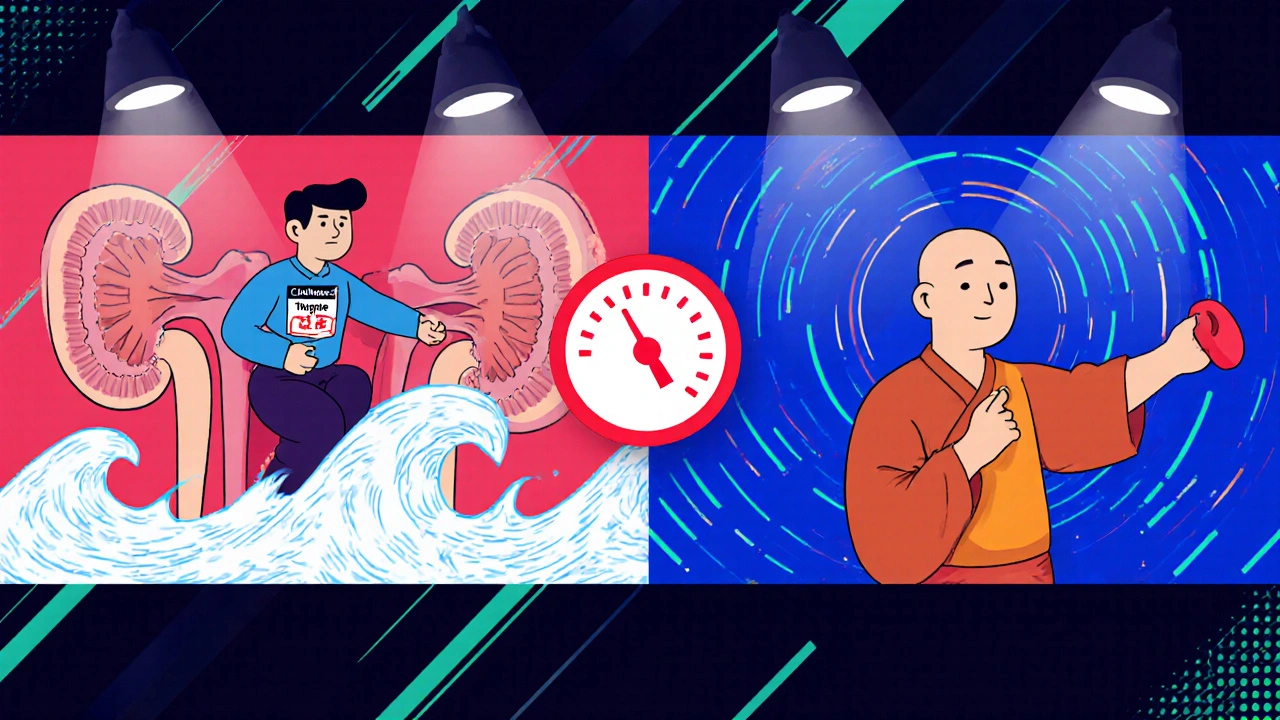Blood Pressure Medication Selector
This tool helps you understand which blood pressure medications might be most appropriate for your specific situation based on key medical factors. Select your conditions and preferences to get personalized recommendations.
How to Use This Tool
This tool provides guidance based on medical factors discussed in the article. Remember: always consult your healthcare provider for personalized treatment decisions. The information is for educational purposes only.
1. What is your blood pressure stage?
2. Do you have any of these conditions?
3. Which side effects are most important to avoid?
4. How important is single-pill convenience to you?
Your Recommendation
Key Takeaways
- Combipres combines a thiazide‑like diuretic (chlorthalidone) with a central‑acting alpha‑2 agonist (clonidine) for a two‑pronged blood‑pressure attack.
- It’s most useful for patients who need stronger control than a single agent can provide but want to avoid high‑dose side effects.
- Common alternatives include hydrochlorothiazide, amlodipine, lisinopril, losartan, spironolactone, atenolol and furosemide.
- When choosing, weigh efficacy, side‑effect profile, cost, kidney function and any existing comorbidities.
- Regular monitoring-blood pressure, electrolytes and glucose-is essential no matter which regimen you pick.
What is Combipres?
When treating hypertension, Combipres is a fixed‑dose combination pill that pairs two well‑known agents: chlorthalidone and clonidine hydrochloride. It’s marketed in several countries for patients who need more than one drug to reach target blood‑pressure numbers but who would rather take a single tablet than multiple pills.
How the Two Components Work Together
Chlorthalidone belongs to the thiazide‑like diuretic class. It acts on the distal convoluted tubule of the kidney, increasing sodium and water excretion. The resulting drop in plasma volume lowers cardiac output, and long‑term it also reduces peripheral vascular resistance.
Clonidine hydrochloride is a centrally acting alpha‑2 adrenergic agonist. It stimulates receptors in the brainstem, decreasing sympathetic outflow. The net effect is reduced heart‑rate, lower cardiac output and vasodilation.
By coupling a volume‑depleting agent with a sympathetic‑blocking one, Combipres attacks high blood pressure from two angles, often achieving better control than escalating the dose of either component alone.
Who Might Benefit From Combipres?
Combipres is typically considered for:
- Adults with stage 2 hypertension (≥ 160/100 mmHg) who have not responded adequately to monotherapy.
- Patients who prefer a single‑pill regimen to improve adherence.
- Individuals with a documented diuretic‑responsive component (e.g., fluid‑retention) plus a sympathetic‑driven component (e.g., stress‑related spikes).
- Those without contraindications to either chloroquine‑type diuretics (e.g., severe renal impairment) or clonidine (e.g., recent myocardial infarction).

Alternatives on the Market
If Combipres isn’t a fit, clinicians have a toolbox of single‑agent or combination options. Below is a quick snapshot of the most common alternatives.
Hydrochlorothiazide - another thiazide diuretic, often started at 12.5‑25 mg daily.
Amlodipine - a long‑acting calcium‑channel blocker, effective for isolated systolic hypertension.
Lisinopril - an ACE inhibitor that also offers renal protection in diabetic patients.
Losartan - an ARB (angiotensin II receptor blocker) often used when ACE inhibitors cause cough.
Spironolactone - a potassium‑sparing diuretic useful in resistant hypertension.
Atenolol - a beta‑blocker, beneficial when heart‑rate control is also needed.
Furosemide - a loop diuretic reserved for volume overload states or renal impairment.
Side‑Effect Profiles at a Glance
| Medication | Drug Class | Common Side‑Effects | Notable Contra‑indications | Typical Daily Dose |
|---|---|---|---|---|
| Combipres | Thiazide‑like diuretic + Central alpha‑2 agonist | Electrolyte loss, dry mouth, dizziness, fatigue | Severe renal failure, pheochromocytoma, recent MI | 12.5 mg chlorthalidone / 0.1 mg clonidine |
| Hydrochlorothiazide | Thiazide diuretic | Hypokalemia, hyperuricemia, photosensitivity | Gout, sulfonamide allergy | 12.5‑50 mg |
| Amlodipine | Calcium‑channel blocker | Peripheral edema, gingival hyperplasia, headache | Severe aortic stenosis | 5‑10 mg |
| Lisinopril | ACE inhibitor | Cough, hyperkalemia, angioedema | Pregnancy, history of angioedema | 10‑40 mg |
| Losartan | ARB | Dizziness, hyperkalemia, renal function drop | Pregnancy, bilateral renal artery stenosis | 25‑100 mg |
| Spironolactone | Potassium‑sparing diuretic | Gynecomastia, hyperkalemia, menstrual irregularities | Severe kidney disease, hyperkalemia | 25‑100 mg |
| Atenolol | Beta‑blocker | Bradycardia, fatigue, cold extremities | Severe asthma, COPD, bradycardia | 25‑100 mg |
| Furosemide | Loop diuretic | Otitis media, ototoxicity, electrolyte disturbances | Anauria, severe electrolyte loss | 20‑80 mg |
Pros and Cons of Combipres Compared to Each Alternative
Pros
- Dual mechanism often yields faster BP reduction.
- Single‑pill convenience improves adherence.
- Lower dose of each component may reduce dose‑related side‑effects.
Cons
- Fixed dose-cannot titrate chlorthalidone and clonidine independently.
- Clonidine can cause rebound hypertension if stopped abruptly.
- Potential for additive electrolyte disturbances (especially potassium loss).
When you stack Combipres against Hydrochlorothiazide, you gain the central‑acting effect of clonidine, which can be a game‑changer for patients whose BP spikes at night. Against Amlodipine, you trade vascular relaxation for volume reduction; the choice often hinges on whether the patient has edema (favoring amlodipine) or fluid overload (favoring Combipres).
Compared with Lisinopril or Losartan, Combipres lacks renoprotective benefits but avoids the cough and angioedema risks associated with ACE inhibitors and ARBs. For patients with chronic kidney disease, an ACE/ARB may be preferable.
In resistant cases, adding Spironolactone to a regimen that already includes Combipres can be effective, but watch potassium closely.

Practical Considerations: Cost, Monitoring, and Lifestyle
Cost varies by country; in Australia, a 30‑day supply of Combipres is roughly AU$30‑40, comparable to buying separate chlorthalidone and clonidine tablets. Insurance coverage is generally good because both components are approved antihypertensives.
Monitoring schedule:
- Baseline labs: electrolytes (Na, K), creatinine, fasting glucose.
- Re‑check BP and labs after 2 weeks, then monthly for the first 3 months.
- Long‑term: electrolytes every 3‑6 months, renal function annually.
Lifestyle advice applies regardless of drug choice: low‑salt diet, regular aerobic exercise, weight management, moderation of alcohol.
How to Choose the Right Pill for You
Think of the decision as a simple flowchart:
- If you need a strong diuretic effect and have no heart‑rate concerns → consider Combipres or a high‑dose thiazide.
- If you have persistent nocturnal spikes or high sympathetic tone → clonidine component gives an edge.
- If you experience chronic cough or angioedema → stay away from ACE inhibitors, consider ARBs or Combipres.
- If you’re pregnant or planning pregnancy → avoid both clonidine and ACE/ARBs; opt for labetalol or methyldopa.
- If you have severe renal impairment (eGFR <30 mL/min) → avoid thiazide‑type agents; loop diuretic or non‑diuretic classes are safer.
Always discuss these points with your prescriber; the best drug is the one that fits your medical picture and your daily routine.
Frequently Asked Questions
What is the exact dose of each component in Combipres?
Combipres is typically formulated as 12.5 mg of chlorthalidone plus 0.1 mg of clonidine hydrochloride per tablet. Some markets offer a 25 mg/0.2 mg strength for patients needing a stronger effect.
Can I switch from a separate chlorthalidone and clonidine regimen to Combipres?
Yes, many doctors transition patients to the combo pill to improve adherence. The key is to match the total daily dose of each component and to taper clonidine gradually to avoid rebound hypertension.
What are the main side‑effects I should watch for?
Watch for low potassium, dizziness, dry mouth, or excessive fatigue. If you notice a rapid heartbeat, severe headache, or swelling of the lips/tongue, seek medical help right away.
Is Combipres safe for people with diabetes?
Generally yes, but thiazide‑type diuretics can raise blood‑sugar modestly. Regular glucose monitoring is advised, especially when starting therapy.
How does Combipres compare cost‑wise to taking the two drugs separately?
In most pharmacies the combo pill costs about the same as buying the two single agents, sometimes a little less because of bulk pricing. Insurance plans usually cover it under the same category as other antihypertensives.
Bottom line: Combipres offers a handy two‑in‑one solution for certain hypertensive patients, but it isn’t a universal answer. By weighing the pros and cons against alternatives like hydrochlorothiazide, amlodipine, ACE inhibitors or ARBs, you can land on a regimen that keeps your blood pressure in check without unwanted side‑effects.







naoki doe
October 26, 2025 AT 16:58Combipres packs both a thiazide and a clonidine, so you get volume loss plus sympathetic dampening in one pill. This dual action can drop systolic numbers faster than upping the dose of a single agent. It also means you’ll need to watch electrolytes more closely, especially potassium. For patients prone to orthostatic hypotension the clonidine component might add a bit of dizziness. Overall it’s a convenience boost for those juggling multiple scripts.
sarah basarya
November 2, 2025 AT 15:38The whole fanfare around Combipres feels like a circus act, because a cheap HCTZ plus lifestyle tweaks can do the job just as well. You’re basically paying for a brand‑name combo when a simple diuretic plus diet already cuts your pressure in half. Sure, the clonidine adds a night‑time dip, but that can be achieved with a beta‑blocker for many people. Adding more pills just ramps up the risk of electrolyte swings and dry mouth. In the end, the hype outweighs the actual benefit for most patients.
Miracle Zona Ikhlas
November 9, 2025 AT 14:18For anyone nervous about juggling meds, Combipres simplifies the regimen to one tablet a day. It’s especially handy if you’ve already tried a solo thiazide and still see spikes. Just keep an eye on labs and you should be good.
Tony Stolfa
November 16, 2025 AT 12:58Look, if you want a pill that pretends to be a masterpiece, Combipres is the billboard advertisement for that. It throws two mechanisms together like a cheap mixtape, hoping the marketing will cover the side‑effects. You’ll still get the usual thiazide‑induced potassium loss plus clonidine‑driven dry mouth. And don’t forget the rebound hypertension if you quit cold turkey. It’s not elite, it’s just a convenience with a price tag.
Joy Dua
November 23, 2025 AT 11:38Combipres merges two pharmacologic strata-diuretic and central sympatholytic-a synergy that eclipses monotherapy. Electrolyte surveillance becomes non‑negotiable, especially potassium. The central action curbs nocturnal spikes without additional nocturnal dosing. Patients must taper clonidine slowly to avoid rebound elevations. Overall the formulation offers a compact therapeutic strategy.
Holly Kress
November 30, 2025 AT 10:18I appreciate the convenience of a single‑pill regimen, but I’d caution anyone starting Combipres to monitor blood pressure closely during the first weeks. The combination can produce a quick dip, which is great if you’ve got stage‑2 hypertension, yet it may also cause dizziness in the elderly. Make sure kidney function is stable before initiating therapy. If side‑effects arise, adjusting the dose of each component separately isn’t an option, so discuss alternatives with your clinician.
Chris L
December 7, 2025 AT 08:58From a collaborative standpoint, Combipres can be a solid stepping stone for patients struggling with adherence. The dual mechanism addresses both volume excess and sympathetic overdrive, which many resistant hypertensives exhibit. Pair it with lifestyle counseling and regular electrolyte checks, and you have a comprehensive plan. I’ve seen several patients stabilize their numbers within a month on this combo. Keep the communication open, and don’t hesitate to tweak if side‑effects emerge.